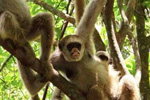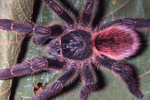The Brazilian government offers tax relief to landowners who set aside areas for preservation. While this has expanded the system of private ecological reserves considerably, the Brazilian government currently lacks funding to enforce the protection of these lands from threats such as hunting, leaving the responsibility to the landowners.
To address the question of how to effectively protect these areas, a group of researchers compared mammal abundance before and after the initiation of a guard patrol system in the 3,096 hectare Reserva Ecológica Michelin (REM) in mongabay.com’s open access journal Tropical Conservation Science (TCS). They found that wildlife populations did recover after the initiation of a guard patrol system, with relative abundance of the fauna increasing by 72.6%. The study suggests that, “effective protection is possible in heavily hunted landscapes” and “the private reserve initiative can be an effective component of the national conservation strategy.”
The REM is located in costal Bahia, one of the most species-rich parts of the Brazilian Atlantic Forest System. But rampant hunting, timber felling, firewood collecting, forest clearing, and a high human population density have caused huge declines in biodiversity in this region. Hunting, historically a subsistence activity in the Atlantic Forest, has become a leisure activity and has driven many animals to local extinction including: the red and green macaw (Ara chloropterus), the jaguar (Panthera onca) and brown howler monkey (Alouatta guariba).
Four guards were hired to patrol the REM. The unarmed guards patrolled by foot and found that they could effectively deter hunters by disabling and removing their traps, chasing away hunting dogs, or simply asking the hunters to leave. The researchers identified that hiring men from the local community was a crucial part of the strategy as local guards are “familiar with the forest, have an extensive network of family and friends in the surrounding landscape, and know who the problem hunters are.”
In the REM, the guard system proved to be effective, but at an annual cost of $9.4/hectare the price may be too high for individual property owners. For the growing network of private reserves to safeguard wildlife, reserve owners must find creative ways to finance the protection of reserves, such as investing in agriculture.
“Beyond the problem of costs,” the study states, “the fundamental issue is that unless the local farmers change their inherent values concerning wildlife conservation, the existing tension between opposing visions of how wildlife resources should be used will remain. Reserve owners must therefore remain vigilant if they are to adequately protect their forests.”
Flesher, K. M. and Laufer, J. Protecting wildlife in a heavily hunted biodiversity hotspot: a case study from the Atlantic Forest of Bahia, Brazil. Mongabay.com Open Access Journal – Tropical Conservation Science Vol.6 (2):181-200, 2013
Related articles
Loss of big fruit-eating birds impacting trees in endangered rainforests
(05/31/2013) The extinction of large, fruit-eating birds in fragments of Brazil’s Atlantic rainforest has caused palm trees to produce smaller seeds over the past century, impacting forest ecology, finds a study published in the journal Science.
New insect discovered in Brazil, only third known in its bizarre family (photos)

(04/15/2013) A new species of forcepfly named Austromerope brasiliensis, was recently discovered in Brazil and described in the open access journal Zoo Keys. This is the first discovery of forcepfly in the Neotropics and only the third known worldwide. The forcepfly, often called the earwigfly because the male genital forceps closely resemble the cerci of the common earwig, remains a scientific enigma due to the lack of information on the family.
New species tree-dwelling porcupine discovered in critically threatened Brazilian habitat
(04/11/2013) Scientists in Brazil have described a new species of tree-dwelling porcupine in the country’s most endangered ecosystems. The description is published in last week’s issue of Zootaxa.
Nest of one of world’s rarest birds discovered for the first time
(01/17/2013) A nest belonging to one of the world’s rarest birds has been discovered by researchers for the first time in Brazil, reports the American Bird Conservancy.
Recovery of Atlantic Forest depends on land-use histories
(12/10/2012) The intensity of land-use influences the speed of regeneration in tropical rainforests, says new research. Tropical rainforests are a priority for biodiversity conservation; they are hotspots of endemism but also some of the most threatened global habitats. The Atlantic Forest stands out among tropical rainforests, hosting an estimated 8,000 species of endemic plants and more than 650 endemic vertebrates. However, only around 11 percent of these forests now remain.
Endangered muriqui monkeys in Brazil full of surprises

(11/26/2012) On paper, the northern muriquis (Brachyteles hypoxanthus) look like a conservation comeback story. Three decades ago, only 60 of the gentle, tree-dwelling primates lived in a fragment of the Atlantic Forest along the eastern coast of Brazil. Now there are more than 300. But numbers don’t tell the whole story, according to anthropologist Karen Strier and theoretical ecologist Anthony Ives of the University of Wisconsin, Madison. The pair analyzed 28 years of data on the demographics of the muriquis, one of the longest studies of its kind. They found surprising patterns about birth and death rates, sex ratios, and even how often the monkeys venture out of their trees. These findings raise questions about the muriquis’ long-term survival and how best to protect them, the scientists wrote in the Sept 17 issue of PLoS ONE.
Happy Halloween: nine new species of tree-climbing tarantula discovered

(10/31/2012) If you suffer from acute arachnophobia, this is the perfect Halloween discovery for you: a spider expert has discovered nine new species of arboreal (tree-dwelling) tarantulas in the Brazil. Although tarantula diversity is highest in the Amazon rainforest, the new species are all found in lesser-known Brazilian ecosystems like the Atlantic Forest, of which less than 7 percent remains, and the cerrado, a massive savannah that is being rapidly lost to agriculture and cattle ranching.
Key mammals dying off in rainforest fragments

(08/15/2012) When the Portuguese first arrived on the shores of what is now Brazil, a massive forest waited for them. Not the Amazon, but the Atlantic Forest, stretching for over 1.2 million kilometers. Here jaguars, the continent’s apex predator, stalked peccaries, while tapirs waded in rivers and giant anteaters unearthed termites mounds. Here, also, the Tupi people numbered around a million people. Now, almost all of this gone: 93 percent of the Atlantic Forest has been converted to agriculture, pasture, and cities, the bulk of it lost since the 1940s. The Tupi people are largely vanished due to slavery and disease, and, according to a new study in the open access journal PLoS ONE, so are many of the forest’s megafauna, from jaguars to giant anteaters.
Deforestation in Brazil’s Mata Atlantica drops
(06/06/2012) Deforestation of Brazil’s Mata Atlântica — a forest ecosystem more threatened than the Amazon rainforest — fell to 133 square kilometers between 2010 and 2011, down about 14.7 percent from the annual average between 2008 and 2010, reports Brazil’s National Institute for Space Research (INPE) and Fundação SOS Mata Atlântica.